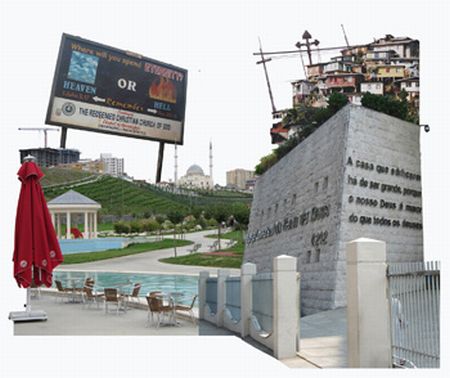THE URBAN CULTURES OF GLOBAL PRAYERS
Neue Gesellschaft für Bildende Kunst | NGBK
Oranienstr. 25 - Berlin
November 12, 2011–January 8, 2012
Gilles Aubry (CH), Sabine Bitter / Helmut Weber (AT/CA), Lía Dansker (AR), Aryo Danusiri (ID), Katja Eydel (D), Frida Hartz (MX), Magdalena Kallenberger / Dorothea Nold (D), Verónica Mastrosimone (AR), Rika Collective (KE), Sandra Schäfer (D), Surabhi Sharma (IN), Sevgi Ortaç (TR), Jens Wenkel / Lagos Film Workshop (NG), Paola Yacoub (LB)
In Lagos, the largest Pentecostal church offers room for five times as many believers as the world’s biggest soccer stadium; a very own City of God is emerging on the outskirts of the metropolis. In Beirut, Islamist organizations are taking charge of rebuilding quarters destroyed during the war and control the provision of housing. In Rio de Janeiro, movie theaters are converted into temples, while in Mumbai public spaces temporarily become stages for religious theater. New religious movements demonstrate their physical presence in the streets and are expanding their territory.
New religious movements and organizations obviously play an increasingly important role in the large cities of the world. They are transforming the urban topography, appearing as economic as well as political players, and often replacing the role of the state—across all regions and religions.
For the first time, the exhibition the Urban Cultures of Global Prayers at the Neue Gesellschaft für Bildende Kunst (Berlin) offers differentiated insights into cultures, policies, and economies of faith in urban space, into the interrelations between urban development and sacred practices, between promises of spiritual redemption and social liberation. Beyond ideological debates on the “regained strength of religiosity”, it becomes evident in the works of the artists from twelve countries that big cities are also always places of religious innovation.
In photo sequences, video installations, and soundscapes, they above all address the cultural and urban practices of globally active, new religious movements, allowing viewers to experience urban settings, strategies, and productions of meaning of religious players and communities in metropolises of the Global South such as Lagos, Mumbai, Rio de Janeiro, Beirut, Kinshasa, Mexico City, Buenos Aires, Nairobi, or Tehran—but also in New York, Istanbul, and Berlin.
Neue Gesellschaft für Bildende Kunst | NGBK
Oranienstr. 25 - Berlin
November 12, 2011–January 8, 2012
Gilles Aubry (CH), Sabine Bitter / Helmut Weber (AT/CA), Lía Dansker (AR), Aryo Danusiri (ID), Katja Eydel (D), Frida Hartz (MX), Magdalena Kallenberger / Dorothea Nold (D), Verónica Mastrosimone (AR), Rika Collective (KE), Sandra Schäfer (D), Surabhi Sharma (IN), Sevgi Ortaç (TR), Jens Wenkel / Lagos Film Workshop (NG), Paola Yacoub (LB)
In Lagos, the largest Pentecostal church offers room for five times as many believers as the world’s biggest soccer stadium; a very own City of God is emerging on the outskirts of the metropolis. In Beirut, Islamist organizations are taking charge of rebuilding quarters destroyed during the war and control the provision of housing. In Rio de Janeiro, movie theaters are converted into temples, while in Mumbai public spaces temporarily become stages for religious theater. New religious movements demonstrate their physical presence in the streets and are expanding their territory.
New religious movements and organizations obviously play an increasingly important role in the large cities of the world. They are transforming the urban topography, appearing as economic as well as political players, and often replacing the role of the state—across all regions and religions.
For the first time, the exhibition the Urban Cultures of Global Prayers at the Neue Gesellschaft für Bildende Kunst (Berlin) offers differentiated insights into cultures, policies, and economies of faith in urban space, into the interrelations between urban development and sacred practices, between promises of spiritual redemption and social liberation. Beyond ideological debates on the “regained strength of religiosity”, it becomes evident in the works of the artists from twelve countries that big cities are also always places of religious innovation.
In photo sequences, video installations, and soundscapes, they above all address the cultural and urban practices of globally active, new religious movements, allowing viewers to experience urban settings, strategies, and productions of meaning of religious players and communities in metropolises of the Global South such as Lagos, Mumbai, Rio de Janeiro, Beirut, Kinshasa, Mexico City, Buenos Aires, Nairobi, or Tehran—but also in New York, Istanbul, and Berlin.
